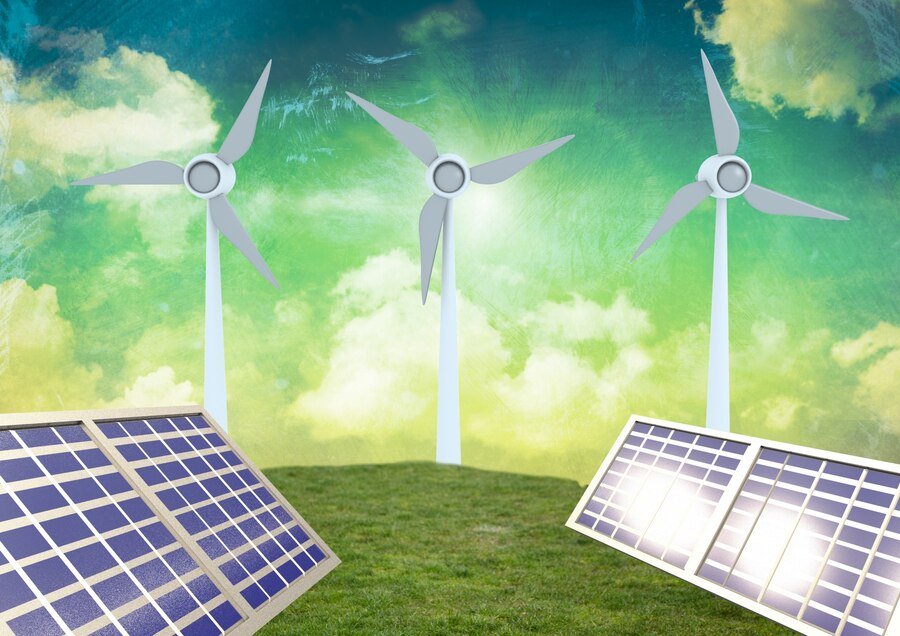introduction
In a world where the demands for energy are ever-growing, the need for sustainable solutions has never been more pressing. The transition from traditional energy sources to renewable energy is one of the most significant shifts in modern society, reshaping everything from how we power our homes to the vehicles we drive. The phrase “From Grid to Glory” encapsulates this transition, representing a journey from reliance on traditional power grids to an era where renewable energy and electric innovation are at the forefront of our lives.This shift isn’t just about making better choices for the environment; it’s about embracing a new way of living, working, and thinking.

Powering the Future: The Evolution of Energy Systems
Historically, electricity was generated primarily through the burning of fossil fuels—coal, oil, and natural gas. This centralized power grid system relied on large power plants to produce energy, which was then distributed across cities and towns. However, this traditional model is no longer sustainable, both for the planet and for the future of energy.
The Shift to Renewable Energy
The world has begun to move away from fossil fuels, and the rise of renewable energy sources is at the heart of this transformation. Solar, wind, geothermal, and hydroelectric power are now playing a major role in energy generation. The key drivers behind this shift are:
Sustainability: Renewable energy sources generate clean power, reducing greenhouse gas emissions and helping combat climate change.
Decentralization: The move from centralized grids to decentralized energy systems allows communities, businesses, and even individuals to generate their own electricity through solar panels or wind turbines, reducing dependence on traditional grids.
Cost-Effectiveness: As technology advances and production scales up, renewable energy has become increasingly affordable. Solar power, for instance, has seen a massive drop in installation costs, making it more accessible to consumers.
The Role of Smart GridsThe smart grid represents the next step in modernizing our energy infrastructure. Unlike traditional grids, which were inefficient and prone to outages, the smart grid uses advanced digital technology to monitor and manage the flow of electricity. The integration of renewable energy sources into this grid allows for a more flexible, efficient, and reliable energy distribution system.
Electric Vehicles: Charging Toward a Sustainable Future
When we think about the transition from grid to glory, one of the most visible changes is happening in the automotive industry. Electric vehicles (EVs) have rapidly evolved from being a novelty to becoming a central part of the global shift towards sustainable living. Today, EVs are synonymous with modern innovation and environmental consciousness.
The Rise of Electric Mobility
The EV revolution is driven by a number of factors:
Zero Emissions: Electric vehicles are free from tailpipe emissions, making them a cleaner alternative to traditional gasoline-powered cars. This reduction in emissions helps mitigate air pollution and reduce our carbon footprint.
Performance: Modern electric vehicles are no longer just about efficiency; they also deliver impressive performance. Brands like Tesla, Lucid Motors, and Rivian are proving that electric cars can offer exceptional speed, range, and handling.
Lower Operating Costs: EVs are cheaper to maintain than traditional cars because they have fewer moving parts and no need for regular oil changes. Additionally, charging an electric car is much cheaper than fueling a gasoline car.
Advanced Technology: EVs are often equipped with cutting-edge technology, such as autonomous driving features, smart navigation, and connected vehicle systems.
Building the Infrastructure
As EV adoption increases, so too does the need for robust charging infrastructure. The shift from grid-based electricity to electric vehicles relies on building an extensive network of fast-charging stations that allow drivers to charge their vehicles quickly and conveniently. Many cities are now prioritizing the installation of public charging points, making it easier for EV owners to stay connected to the grid and keep their vehicles powered.
Solar Power: Harnessing the Sun’s Glory
Solar power is one of the most accessible forms of renewable energy, and it has the potential to play a major role in the transition from grid-based power to sustainable electricity. Solar panels are now seen not only on rooftops but on entire solar farms, creating vast networks of clean energy.
The Power of the Sun
Solar energy is abundant, renewable, and relatively easy to harness. With solar panel technology becoming more affordable and efficient, homeowners, businesses, and even entire communities can generate their own electricity from the sun. Solar energy offers several key advantages:Renewable and Clean: Solar energy is an inexhaustible resource that produces no pollution.
Cost Savings: Solar power can significantly reduce electricity bills, and in some areas, governments offer incentives or subsidies to make solar panel installation more affordable.
Energy Independence: By generating their own electricity, consumers become less dependent on the traditional power grid, gaining greater control over their energy consumption.
Solar-Powered Communities
There is a growing movement to create solar-powered communities, where entire neighborhoods rely on renewable energy. This not only reduces their reliance on traditional power grids but also helps create a more resilient and sustainable way of living. By integrating solar power into microgrids, entire communities can produce, store, and share their own electricity.
Wind Power: Harnessing Nature’s Energy
In addition to solar power, wind energy is another key player in the shift from grid-based energy to a more sustainable future. Large-scale offshore and onshore wind farms are rapidly expanding around the world, contributing to the global supply of renewable energy.
Wind’s Growing Impact
Massive Potential: Wind power has the potential to supply up to 40% of the world’s electricity needs if harnessed efficiently. Wind turbines are being installed on land and offshore to take advantage of high wind speeds.
Sustainability: Like solar, wind energy produces zero emissions and helps mitigate climate change. The wind is also an abundant and renewable resource, making it an ideal candidate for long-term sustainable power generation.
The Integration of Wind and Solar
The combination of wind and solar power offers an even more efficient energy system. Since wind and solar often produce power at different times of day or in different weather conditions, combining the two allows for a more consistent and reliable energy supply. Smart grids can manage this dual power source, ensuring that energy is always available when needed.
From Grid to Glory: The Future of Energy
The journey from grid to glory is only just beginning. As we continue to transition toward a more sustainable future, the fusion of renewable energy sources, electric vehicles, and smart technology is paving the way for a world where energy is cleaner, more efficient, and more accessible than ever before.
What’s Next?
Energy Storage Solutions: As renewable energy sources like solar and wind are intermittent, the development of better energy storage technologies—such as batteries and energy storage systems—will allow us to store excess energy for use during times when production is low.
Decentralized Energy Networks: The future will see a shift toward peer-to-peer energy sharing networks, where homes and businesses generate and exchange energy directly, reducing dependence on centralized.

Conclusion:
Carbon-Free Cities: Urban areas are increasingly becoming the focal points of the renewable energy revolution. Cities are embracing green infrastructure, electric mobility, and smart grid technology to reduce their carbon footprints and create more sustainable living environments.The transition from grid-based energy to renewable, electric-powered solutions is a monumental step toward a sustainable future. Solar, wind, and electric vehicles are not just part of a trend; they represent the shift towards a new, clean, and efficient way of life.As we continue to move away from fossil fuels and traditional grids, we embrace a future where sustainability, efficiency, and innovation are at the heart of everything we do. This is the essence of “From Grid to Glory”—a journey toward a world where the energy we use is as clean, powerful, and forward-thinking as the technologies that harness it. The future is electric, and it’s glorious.

